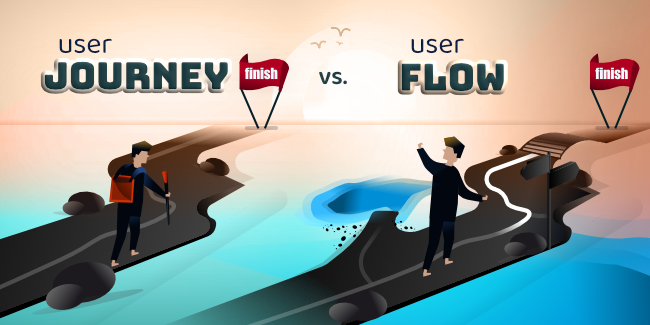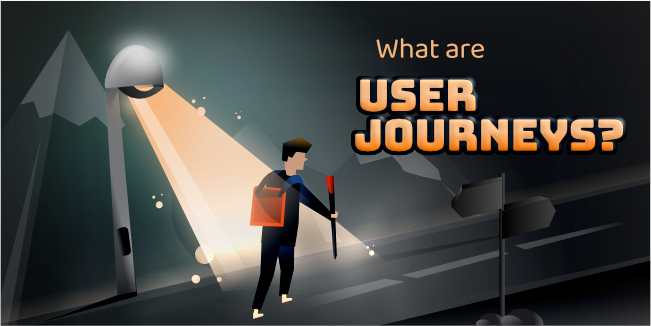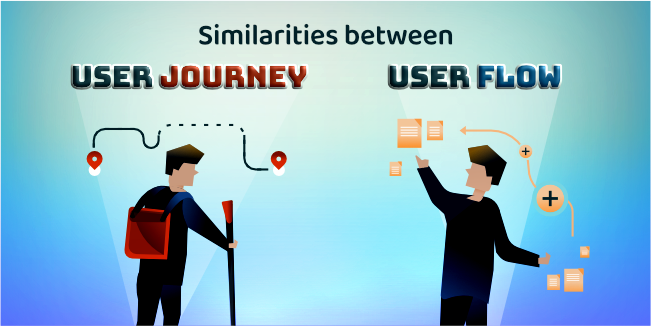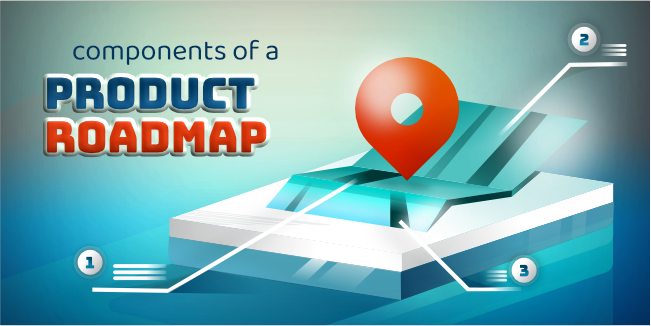productroadmap
userstory
userjourney
userflow
discoveryworkshop
Product Roadmap - how to write user stories and user flows?

They say a plan is half the battle. It probably has a lot of truth, but we know that any plan will not help much. Therefore, it is essential to be detailed, refined and checked. In this, the fifth stage of our Discovery Workshop, you will learn how to make such a plan and use it to make your product meet your expectations.
What is a roadmap?
The product roadmap is an overall plan that describes your vision for product development. It will allow you to formulate the point to which you want to bring the product and define the answer to the question - of why it is worth investing. A product roadmap in an Agile environment also facilitates learning and change. The only way to achieve these aspects is to implement a goal-oriented roadmap rather than one dominated by many functionalities.
We are creating a product roadmap for your digital product during our Discovery Workshops. After that, we split that into a backlog roadmap. We write user stories, and user flows. We can take that as input if you already have a product backlog. From there, we prioritize what should be in the first sprint. The first sprint is always the riskiest if we build the right thing. Therefore, it is crucial to get feedback early and often during development. Our team will help you with that by doing user testing, stakeholder interviews, and beta releases.
We also help you with product strategy. It is essential because it ensures that your product is aligned with your business goals. We take a data-driven approach to product strategy and use analytics to inform our decisions.
What are the benefits of a roadmap?
A roadmap can provide several significant benefits:
- It helps you communicate how you see product development.
- It helps in defining the product and company strategy. By anticipating how your product will develop, you can show how and when your company's goals will be achieved. It makes it easier to plan and secure your next year's budget.
- Helps stakeholders to coordinate the development, marketing, and sales activities.
- Facilitates effective portfolio management. It helps in synchronizing the development of several different products.
- Using a roadmap supports and complements the product backlog.
Implementing a roadmap can have a positive impact on your product backlog. While the roadmap takes care of aspects related to strategic product planning, it also helps to focus on tactical canvas/backlog development. Let's say you and your team release a new version every three months. I suggest that the roadmap includes visions for the next four editions and that the product backlog is focused on the next one.
So after idea validation and user research, we create a product roadmap which is a bird's eye view of the product. Thanks to that, your development team members and stakeholders will know when you want to implement new features. But if you're going to bring into a time, you need user stories, and user flows.
User Journey vs. User Flow

The terms user journey and user flow describe the product's narrative from the user's standpoint. They aid in making the product experience better. Both of these phrases are frequently used interchangeably. In many respects, they are comparable, but they also have their differences. So, are they the same thing?
In a nutshell, the user journey provides a high-level overview of the user's experience with a product. In contrast, the user flow goes into great depth about how it is accomplished. They, however, concentrate on different aspects of design. So, what makes them so unique yet similar?
What are User Flows?
User Flows are the simpler of the two to grasp. They're represented by flowcharts and are a collection of actions taken by a person to accomplish a goal inside a digital product. The user flow takes them from their entry point through steps towards a successful outcome and final action, such as purchasing a product. A User Flow is rather than showing how customers should feel, and it is instead the breakdown of the real user interface.
Depending on how many various actions you want people to be able to do inside your product, a user flow can range from simple to complex. Your user flow diagram will certainly not be completely linear if an app is straightforward. Consider the numerous phases that may be completed on anyone's mobile software; even without a UX designer, you can imagine how complicated the procedure is! Identifying where problems may occur in your task flows is an essential first step in determining where user flows could be improved.
User Flows are helpful to stakeholders and marketers because they allow them to communicate with non-technical people, such as customers, about what the product will accomplish. They'll be beneficial before you complete your MVP.
Working with your design team on User Flows can help you learn more about your product's design and improve your working relationships.
What are User Journeys?
The User Flow depicts a user's path through your product or service. It's easy to comprehend why the User Journey is frequently confused with it. However, Mapping a User Experience, on the other hand, requires exceptional client knowledge from a Product Manager!

Customer journeys are concerned with the user's emotions, pain points, and goals. In contrast, user flows concentrate on the user's physical route throughout a software or program.
Your map is a metaphor for a client's trip through your platform. It may show you everything a customer encounters with a firm over time, and it can help product teams embrace a more user-centric development method.
How to write user stories?
What to consider when you create user stories? Writing user stories can be challenging, but following that would be much easier.
The tale is typically deemed "done" once the user has completed the stated activity. However, make sure to specify exactly what that means.
Outline subtasks or activities: Assign responsibilities for each of the distinct phases and determine which ones must be completed.
Personas: Who are they? If more than one end-user is involved, consider writing separate stories for them.
Write a narrative for each stage of a more extensive operation.
Listen to your consumers (focus on user feedback) and get their complaints or needs in their own words. There's no need to guess when you can get stories from your users.
Time is a sensitive subject. Many software development teams avoid conversations about time instead of depending on their estimating systems. Once you've identified the user stories, make sure they're accessible to everyone on the team. Stories should be completed in one sprint; however, long-term initiatives should be divided into smaller parts or regarded as their epic.
The differences between a user journey vs. User flow
Experience focus vs. use focus
The user journey is concerned with designing a complete process from beginning to end. In contrast, user flow focuses on each stage down to the screen level.
Journey tracks the emotional path of the user
The user experience is defined by how customers feel about the product. Do users want to continue purchasing the service? The journey to accomplishing this objective will be tracked using the user flow method.
The user journey is the guiding process, user flow is the tool
The user journey guides users to the objective in a user interface, such as the user following this route to acquire the product. The user flow is focused on design. It describes the actions necessary to achieve the objective: the customer must first click on the buy button and then pay.
The similarities between a user journey and user flow

The significant similarities between user journey and user flow are as follows:
Both are consumer-focused. Both detail how a product and users interact. Both describe a user's behavior. Both outline the method of delivery for a fantastic experience. Each serves as an example while developing the connection between product and user.
When to use a user journey vs. User flow?
When to use user journeys?
User journeys can be used to get on the same page about the whole user experience for both technical and non-technical audiences. Product evaluation meetings typically occur when the product team wants to know how customers use their product.
After they've released a product and gathered consumer input, teams may use this data to prioritize feature requests - the user journeys aid in the organization of features based on the demands of the users.
When to use a user flow?
Users who transition through a product's user flow are guided by design and development to create an easy-to-understand interface for the product. It's also helpful in detecting interface problems that already exist.
What is roadmapping on Discovery Workshops?
We focus on Roadmapping with you in Discovery Workshop to create a product roadmap. We gather concepts, features, and requirements from various sources, including customers, partners, sales, support, management, engineering, operations, and product management. Then you evaluate all of those inputs to ensure that what goes on your roadmap is consistent with corporate goals, market possibilities, and team capacity.
What are the components of a product roadmap?
Roadmaps for different types of audiences vary significantly. Each type of roadmap typically has a distinct set of elements. It is crucial to consider who the road map is for and how it will be used when choosing which sort of roadmap to create. Knowing this can assist you in determining the best structure and content for your product strategy.
The following components are frequently included in product roadmaps:
A service, idea, technique, or information that satisfies a need or a want is referred to as a product. It has both tangible and intangible qualities (benefits, features, functions, uses) that a seller provides to customers for purchase.
Goals are measurable, time-bound objectives that have specific success indicators associated with them. They're used in a product roadmap to illustrate the key milestones needed to realize the product vision.
Strategic initiatives are larger projects or important topics of work that must be finished in order to achieve the objectives. You may use a roadmap to illustrate how particular releases and features relate to the strategy.
The term "release" is used to describe the introduction of new features or functionality in a product that benefits customers. Epics and multiple features are frequently included in releases.
An epic is a big user story that can't be completed in one release. It's commonly divided into smaller features or smaller user stories that may be delivered gradually.
A feature is a new or enhanced capability that offers value to users. Features contain more detailed information about new capabilities.
A user story describes a new software feature from the perspective of an end-user, including what the user wants and why they need it. You may use the terms "feature" and "user story" interchangeably.

Roadmaps for different types of audiences vary significantly. It is crucial to consider who the road map is for and how it will be used when choosing which sort of roadmap to create. Each type of roadmap typically has a distinct set of elements. Knowing this can assist you in determining the best structure and content for your product strategy.
A service, idea, technique, or information that satisfies a need or a want is referred to as a product. It has tangible and intangible qualities (benefits, features, functions, uses) that a seller provides to customers for purchase. The following components are frequently included in product roadmaps:
Goals are measurable, time-bound objectives that have specific success indicators associated with them. They're used in a product roadmap to illustrate the key milestones needed to realize the product vision.
Strategic initiatives are larger projects or essential topics of work that must be finished to achieve the objectives. You may use a roadmap to illustrate how particular releases and features relate to the strategy.
The term "release" describes introducing new features or functionality in a product that benefits customers. Epics and multiple features are frequently included in releases.
An epic is a big user story that can't be completed in one release. It's commonly divided into more minor features or smaller user stories that may be delivered gradually.
A feature is a new or enhanced capability that offers value to users. Features contain more detailed information about new capabilities.
A user story describes a new software feature from an end-user's perspective, including what the user wants and why they need it. You may interchangeably use the terms "feature" and "user story."
Roadmaps for new products and updates to existing ones are common. The time scale depends on the level of detail required and might range from days to weeks, months, quarters, and even years.
Status indications for goals, initiatives, and releases. Status indicators for goals, initiatives, releases, epics, and features are a fantastic tool for displaying the current state of a plan. They're even more useful when roadmaps include explicit detail on how the team progresses against its planned work.
Conclusion
Agile software development roadmaps help ensure that new products and updates to existing ones meet customer needs and expectations. Status indicators allow teams to track their progress against their goals, releases, epics, and features.
User stories are a fundamental part of agile software development. They're brief descriptions of features that need to be developed, usually written from the user's perspective. User stories typically follow a simple format: As a < type of user >, I want < some goal > so that < some benefit >.
For example: As a customer, I want to search for products on the website to find what I'm looking for quickly and easily.
Build shared understanding for your team in our Discovery Workshop!

This article is part of our Discovery Workshop series
What is Product Design? What is the Product Discovery and Product Discovery Process? Idea Validation in Practice Now readingProduct Roadmap - how to write user stories and user flows? How to choose a tech stack for your project? How to create a project timeline? How to create a project budget? Functional Requirements Document for your Product What is a Prototype? Build your MVP (Minimum Viable Product) the right way - step by step guide by mDevelopers